Quartiles
What are quartiles?
Quartiles are three positional values (quantiles) that divide a data set into four equal parts.
Each part contains an equal number of elements.
There are three quartiles:
- The first quartile (Q1) represents the first 1/4 of the data set (25%).
- The second quartile (Q2) represents the first 2/4 of the data set (50%).
- The third quartile (Q3) represents the first 3/4 of the data set (75%).
Example: In this series, the first quartile Q1=4.5, the second quartile Q2=6.5, and the third quartile Q3=8.5 divide the distribution into four parts: $$ X = \{ \underbrace{3,4}, \color{red}{Q_1}, \underbrace{5, 6}, \color{red}{ Q_2 }, \underbrace{7, 8}, \color{red}{Q_3}, \underbrace{9, 10} \} $$. Sometimes, the term "quartile zero" (Q0) is used to refer to the first element of the ordered distribution (e.g., 3), and "quartile four" (Q4) to refer to the last element (e.g., 11).
How to calculate quartiles
There are two main methods for calculating quartiles, depending on whether you're working with a simple data series or a frequency distribution.
Series
To calculate the quartiles of a data series:
- Sort the data in ascending order.
- Multiply the number of elements in the series by p=1/4 for Q1, p=2/4 for Q2, and p=3/4 for Q3: $$ k = n \cdot p $$
- Determine the position of the quartile:
- If k is an integer, the quartile is the average of the k-th and (k+1)-th elements in the data set.
- If k is not an integer, round up to the next whole number to find the position of the quartile.
Frequency distributions
To calculate quartiles in a frequency distribution:
- Calculate the cumulative absolute frequencies for each class in the distribution.
- Divide the total cumulative frequency by 1/4, 2/4, and 3/4 to find the positions of Q1, Q2, and Q3 within the cumulative frequencies.
- Identify the frequency intervals that contain Q1, Q2, and Q3. These intervals correspond to the quartiles.
Note: There are several methods for calculating quartiles. For example, some use linear interpolation to estimate the value of the quartile within a class, while others approximate it to the midpoint of the class.
A practical example
Example 1
This data set contains n=9 elements:
$$ X = \{ 9,6,11,8,4,7,10,3,5 \} $$
First, sort the data in ascending order:
$$ X = \{ 3,4,5,6,7,8,9,10,11 \} $$
To calculate the first quartile (Q1), multiply the number of elements (n=9) by 1/4:
$$ k = n \cdot \frac{1}{4} = 9 \cdot \frac{1}{4} = 2.25 $$
Since the result is a decimal, round up to the next whole number (k=3) to find the position of Q1.
$$ X = \{ 3,4,\color{red}{5},6,7,8,9,10,11 \} $$
The third element (k=3) is 5.
$$ Q_1 = 5 $$
Therefore, the first quartile of this data set is Q1=5.
$$ X = \{ 3,4,\underbrace{5}_{Q_1},6,7,8,9,10,11 \} $$
To calculate the second quartile (Q2), multiply the number of elements (n=9) by 2/4:
$$ k = n \cdot \frac{2}{4} = 9 \cdot \frac{2}{4} = 4.5 $$
Since the result is a decimal, round up to the next whole number (k=5) to find the position of Q2.
$$ X = \{ 3,4,5,6,\color{red}{7},8,9,10,11 \} $$
The fifth element (k=5) is 7.
$$ Q_2 = 7 $$
Therefore, the second quartile of this data set is Q2=7.
$$ X = \{ 3,4,5,6,\underbrace{7}_{Q_2},8,9,10,11 \} $$
To calculate the third quartile (Q3), multiply the number of elements (n=9) by 3/4:
$$ k = n \cdot \frac{3}{4} = 9 \cdot \frac{3}{4} = 6.75 $$
Since the result is a decimal, round up to the next whole number (k=7) to find the position of Q3.
$$ X = \{ 3,4,5,6,7,8,\color{red}{9},10,11 \} $$
The seventh element (k=7) is 9.
$$ Q_3 = 9 $$
Therefore, the third quartile of this data set is Q3=9.
$$ X = \{ 3,4,5,6,7,8,\underbrace{9}_{Q_3},10,11 \} $$
In summary, the three quartiles Q1 = 5, Q2 = 7, and Q3 = 9 divide the data into four parts:
$$ X = \{ \underbrace{3,4}, \underset{Q_1}{\color{red}5}, \underbrace{6}, \underset{Q_2}{\color{red}7}, \underbrace{8}, \underset{Q_3}{\color{red}9}, \underbrace{10,11} \} $$
Note: In this case, the three quartiles are approximate values that belong to the data set X.
Example 2
Now let's look at the same data set with one element removed.
This time, the data set contains n=8 elements:
$$ X = \{ 9,6,8,4,7,10,3,5 \} $$
Sort the data in ascending order:
$$ X = \{ 3,4,5,6,7,8,9,10 \} $$
To calculate the first quartile (Q1), multiply the number of elements (n=8) by 1/4:
$$ k = n \cdot \frac{1}{4} = 8 \cdot \frac{1}{4} = 2 $$
Since k=2 is an integer, take the average of the values at positions k=2 and k+1=3.
$$ X = \{ 3,\color{red}4,\color{red}5,6,7,8,9,10 \} $$
The second element (k=2) is 4, and the third element (k=3) is 5.
Therefore, the first quartile of this data set is Q1=4.5.
$$ Q_1 = \frac{4+5}{2} = 4.5 $$
To calculate the second quartile (Q2), multiply the number of elements (n=8) by 2/4:
$$ k = n \cdot \frac{2}{4} = 8 \cdot \frac{2}{4} = 4 $$
Since k=4 is an integer, take the average of the values at positions k=4 and k+1=5.
$$ X = \{ 3,4,5,\color{red}6,\color{red}7,8,9,10 \} $$
The fourth element (k=4) is 6, and the fifth element (k=5) is 7.
Therefore, the second quartile of this data set is Q2=6.5.
$$ Q_2 = \frac{6+7}{2} = 6.5 $$
To calculate the third quartile (Q3), multiply the number of elements (n=8) by 3/4:
$$ k = n \cdot \frac{3}{4} = 8 \cdot \frac{3}{4} = 6 $$
Since k=6 is an integer, take the average of the values at positions k=6 and k+1=7.
$$ X = \{ 3,4,5,6,7,\color{red}8,\color{red}9,10 \} $$
The sixth element (k=6) is 8, and the seventh element (k=7) is 9.
Therefore, the third quartile of this data set is Q3=8.5.
$$ Q_3 = \frac{8+9}{2} = 8.5 $$
In summary, the three quartiles Q1 = 4.5, Q2 = 6.5, and Q3 = 8.5 divide the data into four parts:
$$ X = \{ \underbrace{3,4}, \color{red}{Q_1}, \underbrace{5, 6}, \color{red}{ Q_2 }, \underbrace{7, 8}, \color{red}{Q_3}, \underbrace{9, 10} \} $$
Note: In this case, the three quartiles are approximate values that do not belong to the data set X.
Example 3
Let's consider this frequency distribution:
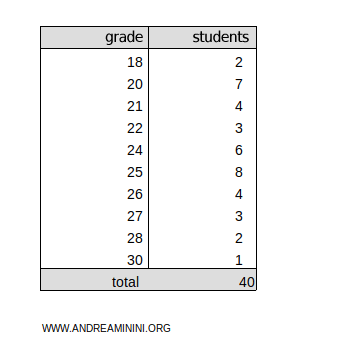
This represents the grades of 40 students. The grades range from 18 to 30, and the frequencies represent how many students achieved each grade.
To find the quartiles, add a column for the cumulative frequencies, starting with the first class.
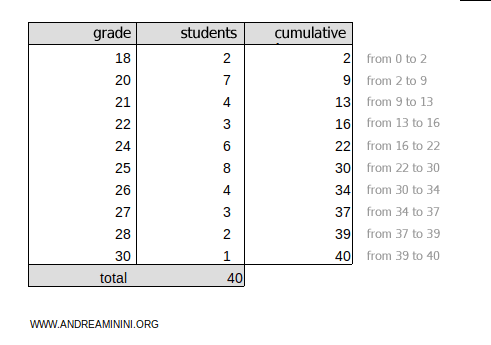
The total cumulative frequency is ftot=40.
To calculate the first quartile, multiply the total cumulative frequency ftot=40 by 1/4:
$$ k =f_{tot} \cdot \frac{1}{4} = 40 \cdot \frac{1}{4} = 10 $$
The result, 10, lies in the cumulative frequency range 9-13.
Therefore, the first quartile is in the class Q1=21.
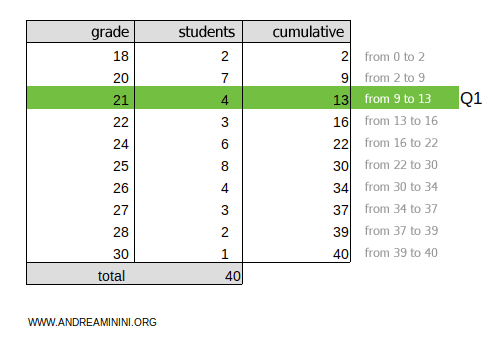
To calculate the second quartile, multiply the total cumulative frequency ftot=40 by 2/4:
$$ k =f_{tot} \cdot \frac{2}{4} = 40 \cdot \frac{2}{4} = 20 $$
The result, 20, lies in the cumulative frequency range 16-22.
Therefore, the second quartile is in the class Q2=24.
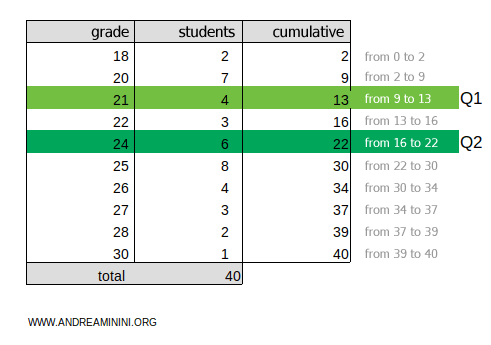
To calculate the third quartile, multiply the total cumulative frequency ftot=40 by 3/4:
$$ k =f_{tot} \cdot \frac{3}{4} = 40 \cdot \frac{3}{4} = 30 $$
The result, 30, lies in the cumulative frequency range 30-34.
Therefore, the third quartile is in the class Q3=26.
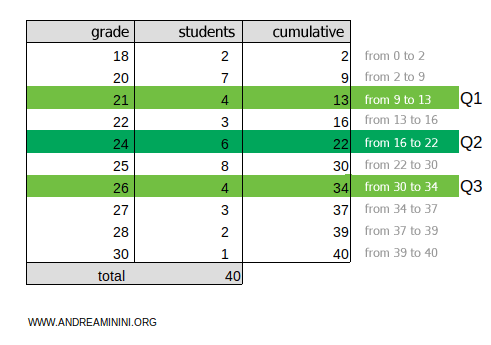
Note: When listing the 40 grades in order from lowest to highest, the three quartiles Q1, Q2, and Q3 divide the series into four equal parts.
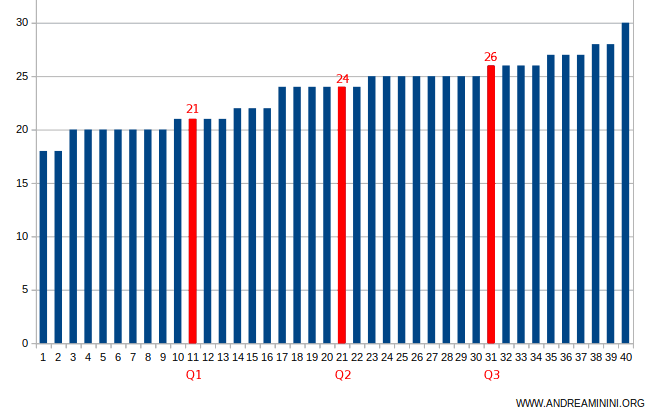
Example 4
This frequency distribution is divided into classes:
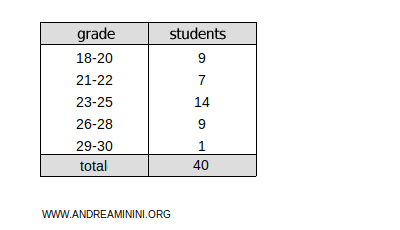
Next, add a column for the cumulative absolute frequencies:
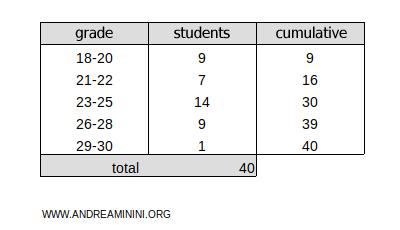
The total cumulative frequency is ftot=40.
To find the first quartile (Q1), multiply the total cumulative frequency ftot=40 by 1/4:
$$ k =f_{tot} \cdot \frac{1}{4} = 40 \cdot \frac{1}{4} = 10 $$
The result, 10, lies within the cumulative frequency range 9-16 for the class 21-22.
In this case, linear interpolation is used to find a more precise quartile value:
$$ Q_1 = x_{inf} + (x_{sup} - x_{inf}) \cdot \frac{c - n_{prec}}{n_{classe}} $$
Here’s what the terms mean:
- xinf=21 and xsup=22 are the boundaries of the class 21-22.
- c=10 is the position of the first quartile.
- nclasse=7 is the frequency of the class 21-22.
- nprec=9 is the cumulative frequency of the classes preceding 21-22.
Substitute the values and calculate:
$$ Q_1 = 21 + (22 - 21 ) \cdot \frac{10 - 9}{7} $$
$$ Q_1 = 21 + 1 \cdot \frac{1}{7} $$
$$ Q_1 = 21.14 $$
Therefore, the first quartile is Q1=21.14.
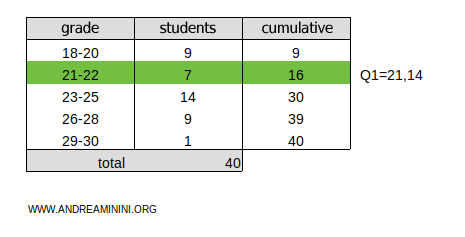
Note: Alternatively, you can approximate the first quartile by calculating the midpoint of the class. In this case, the midpoint of the class 21-22 is 21.5, giving an approximate first quartile of Q1=21.5. This method is quicker but less precise than linear interpolation.
To calculate the second quartile (Q2), multiply the total cumulative frequency ftot=40 by 2/4:
$$ k =f_{tot} \cdot \frac{2}{4} = 40 \cdot \frac{2}{4} = 20 $$
The result, 20, lies within the cumulative frequency range 16-30 for the class 23-25.
Again, we use linear interpolation to find the precise value of the second quartile:
$$ Q_2 = x_{inf} + (x_{sup} - x_{inf}) \cdot \frac{c - n_{prec}}{n_{classe}} $$
Here’s what the terms mean:
- xinf=23 and xsup=25 are the boundaries of the class 23-25.
- c=20 is the position of the second quartile.
- nclasse=14 is the frequency of the class 23-25.
- nprec=16 is the cumulative frequency of the classes preceding 23-25.
Substitute the values and calculate:
$$ Q_2 = 23 + (25 - 23) \cdot \frac{20 - 16}{14} $$
$$ Q_2 = 23 + 2 \cdot \frac{4}{14} $$
$$ Q_2 = 23.57 $$
Therefore, the second quartile is Q2=23.57.
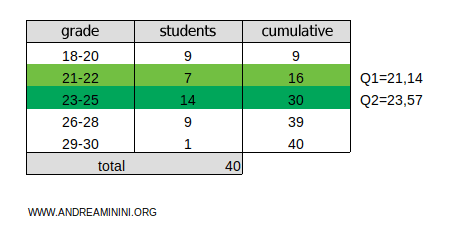
Note: Using the midpoint method, the second quartile would be Q2=24, where 24 is the midpoint of the class 23-25.
To calculate the third quartile (Q3), multiply the total cumulative frequency ftot=40 by 3/4:
$$ k =f_{tot} \cdot \frac{3}{4} = 40 \cdot \frac{3}{4} = 30 $$
The result, 30, lies within the cumulative frequency range 30-39 for the class 26-28.
Once again, linear interpolation is used to find the exact value of the third quartile:
$$ Q_3 = x_{inf} + (x_{sup} - x_{inf}) \cdot \frac{c - n_{prec}}{n_{classe}} $$
Here’s what the terms mean:
- xinf=26 and xsup=28 are the boundaries of the class 26-28.
- c=30 is the position of the third quartile.
- nclasse=9 is the frequency of the class 26-28.
- nprec=30 is the cumulative frequency of the classes preceding 26-28.
Substitute the values and calculate:
$$ Q_3 = 26 + (28 - 26) \cdot \frac{30 - 30}{9} $$
$$ Q_3 = 26 + 2 \cdot \frac{0}{9} $$
$$ Q_3 = 26 $$
Therefore, the third quartile is Q3=26.
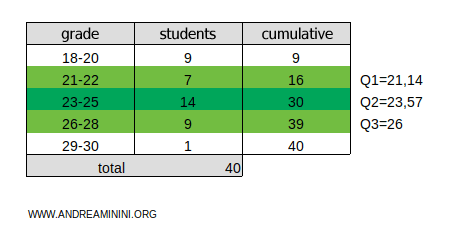
The interquartile range
The interquartile range is the difference between the third quartile (Q3) and the first quartile (Q1): $$ Q_3 - Q_1 $$
For example, if the quartiles of a data set are:
$$ Q_1 = 4.5 $$
$$ Q_2 = 6.5 $$
$$ Q_3 = 8.5 $$
The interquartile range is 4:
$$ Q_3 - Q_1 = 8.5 - 4.5 = 4 $$
And so on.
